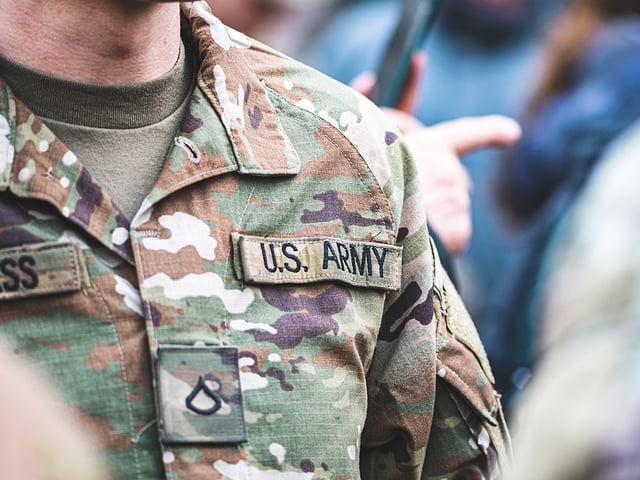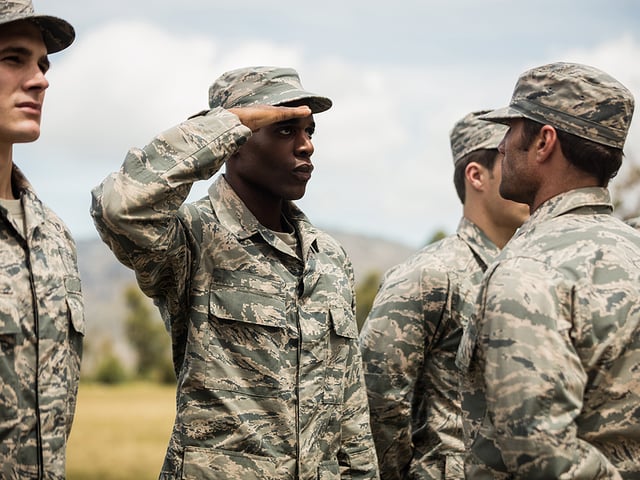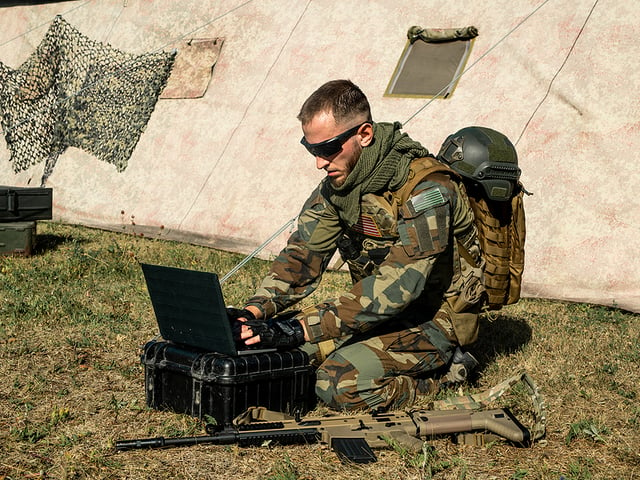
How to Join the Army
So you’re thinking of joining the Army—congrats! The United States Army is the largest branch of the U.S. Department of Defense and offers many opportunities for advancement and promotion. While most traditional jobs require you to submit a resume and hope for an interview, the process for joining the army is quite a bit different.
Army Requirements
Whether you plan on joining the Army as active duty or as a member of the Army Reserve, there are several steps you will need to take before you’re officially “in”. We break them down for you in six requirements below.
Requirement 1: Talk to a Recruiter
The first step in joining the Army is to contact a recruiter. They will conduct a pre-screening to make sure you’re eligible to join the military, asking questions about your health and criminal history, education level, age, marital status, and dependencies. They will also administer a condensed version of the Armed Services Vocational Aptitude Battery, typically referred to as the ASVAB. The ASVAB is a multiple-choice test covering nine subjects: Arithmetic Reasoning, Assembling Objects, Auto and Shop, Electronics Information, General Science, Mathematics Knowledge, Mechanical Comprehension, Paragraph Comprehension, and Word Knowledge. The full test is used to measure career aptitude and abilities and will be given to you at a later date.
Requirement 2: Gather Paperwork
The next requirement involves gathering official documentation. Your recruiter will let you know what you need specifically, but this typically includes things like driver’s license, birth certificate (or proof of citizenship if you were born outside of the United States), marriage certificate, social security card, high school diploma or GED, and a direct-deposit form for your checking account for those future paychecks (yay!). If you participated in ROTC, you will need to furnish proof of completion, and you’ll need to provide rental contract documents for any dependents that live outside of government housing, if that’s applicable to you. The information in these documents will be used to run a background check, so it’s important that you are honest with your recruiter at every step of the process. Prior felonies, domestic violence, and drug-related charges will automatically disqualify a candidate from joining, but lesser drug offenses may be deemed acceptable on a case-by-case basis.
Requirement 3: Take the ASVAB
As mentioned previously, the ASVAB is a nine-section multiple-choice test developed by the Department of Defense that assesses a potential candidate’s cognitive strengths. While there is no “pass” or “fail” grade, doing well on the test is critical, as ASVAB scores determine which military occupational specialty (MOS) candidates qualify for after enlistment—and if you’re able to join the military at all.
ASVAB Scoring
When someone tells you their ASVAB score, they are referring to their Armed Forces Qualification Test (AFQT) Score. The AFQT score is reported as a percentage between 1 and 99, and is calculated from four sections of the test: Arithmetic Reasoning, Mathematics Knowledge, Paragraph Comprehension, and Word Knowledge. The Army requires a minimum AFQT score of 31 for enlistment.
Composite scores (sometimes referred to as line scores) help determine specific military jobs (MOS) you may do well in. While only four test sections are factored into your AFQT score, all nine sections are considered, in various combinations, when calculating your composite score. For example, an Operators and Food (OF) MOS looks at Auto and Shop, Paragraph Comprehension, Mechanical Comprehension, and Word Knowledge scores, whereas a Field Artillery (FA) MOS examines scores in Arithmetic Reasoning, Mathematics Knowledge, and Mechanical Comprehension.
Versions of the ASVAB
Most recruits will take a computerized version of the test (CAT-ASVAB) at a Military Entrance Processing Station (MEPS) near their home. The CAT-ASVAB is adaptive, meaning it adjusts the difficulty level based on previous responses. If a recruit doesn’t live near a MEPS, they will be given a paper and pencil (P&P) version at a satellite Military Entrance Test (MET) site. Both versions of the test are multiple choice and cover the same content. However, because the P&P version isn’t adaptive, it is longer. The CAT-ASVAB contains 135 questions and most finish in an hour and a half, while the P&P ASVAB is 225 questions and typically takes about three hours to complete.
How to Do Well on the ASVAB
It’s normal to be nervous before test day, especially when the test can essentially make or break your military career. Taking ASVAB practice tests in advance can help you get a feel for the style and difficulty level of questions you’ll encounter on test day, and ASVAB study guides and ASVAB flashcards can be a good refresher for concepts you might have learned previously and forgotten. Pay special attention to the four subjects that make up the AFQT score (Arithmetic Reasoning, Mathematics Knowledge, Paragraph Comprehension, and Word Knowledge), and any that might play a role in an MOS you could be interested in—check this out for more on Army Composite Scores. Remember that you can retake the ASVAB if you don’t get the score you want the first time around. If it’s your first or second retake, you must wait one month from the date of your last test, but additional retests beyond that require a six-month waiting period.
Requirement 4: Physical Fitness Evaluation
Every potential Army candidate must undergo a fitness evaluation to make sure they are physically healthy enough to serve. Your recruiter will schedule an appointment at the MEPS closest to you, often the day after your ASVAB so you don’t have to make two separate trips. Because ASVAB testing and the physical examination can be long processes, the entire experience may take two days. If it’s necessary for you to spend the night because of lengthy travel, any hotel or meal expenses you incur will be paid for by MEPS.
You’ll begin your evaluation by filling out a questionnaire. Again, it’s important that you’re honest in your answers, as dishonesty can have serious consequences. Blood and urine will be collected to check for normal values, as well drugs, alcohol, and pregnancy, if applicable. Hearing, vision, and weight will then be assessed. If your weight is outside the acceptable range, you may be disqualified. If weight is a concern for you, you can check the Army physical requirements and body fat calculator. Recruits will be separated by gender and then asked to strip down to their undergarments for a group exercise that will look for any abnormalities in physical ability or balance.
Requirement 5: Choose an MOS
The next requirement before your Army career begins is to choose a specific job, or MOS. The jobs available to you will depend on your ASVAB scores, individual interests, and the current needs of the Army. A service liaison counselor will meet with you one-on-one to discuss your options in private. Because there are more than 200 jobs to choose from, it’s a good idea to research ahead of time so you have some idea about what’s available to you. You can browse some of the different Army career options here.
Requirement 6: Attend Basic Combat Training
The final requirement for joining the Army is to attend Basic Combat Training. Sometimes called “bootcamp” or simply “basic”, Basic Combat Training is required for all active duty, Army Reserve, and Army National Guard candidates. Basic lasts about 10 weeks and is divided into three phases.
Red Phase
The focus of the initial phase, or Red Phase, is learning how to become a soldier and work together as a team with your fellow recruits. You will be given a uniform and an Army regulation haircut if you are male. Women do not need a haircut but are expected to wear their hair in accordance with approved standards. You will be expected to memorize the Warrior Ethos and Soldier’s Creed. You will also engage in physical training, such as road or formation marches, and learn basic first aid and Chemical Radioactive Biological and Nuclear (CRBN) readiness.
White Phase
During the second part of basic, known as the White Phase, you will be taught the basics of rifle marksmanship, maintenance, and target training. You will learn hand-to-hand combat and what to do if multiple assailants attack you at once. Physical training will become more advanced, and will include an obstacle course and a 50-foot rappelling structure known as Warrior Tower.
Blue Phase
In the final weeks of Basic Combat Training, or Blue Phase, you will continue to build on the skills you have learned and also incorporate some new ones. Machine gun and grenade training will be added to your weapons knowledge, and you will also learn how to identify and disable explosive devices. Basic culminates with a land navigation course that lasts several days and tests your skills of navigation using a map and compass.
After completing basic training, you will continue on to Advanced Individual Training (AIT). The location and length of your training will depend on the MOS you selected, but most soldiers typically attend for four to 52 weeks.
Frequently Asked Questions about Joining the Army:
How old do you need to be to join the Army?
You have to be at least 17 years old to join the United States Army, with a maximum age of 35 years to enlist as an active duty recruit. Additionally, you must be a U.S. citizen or permanent resident, able to pass a physical fitness examination, achieve a minimum score on the ASVAB, and have a high school diploma or GED.
Do you have to go to basic training for the Army Reserve?
Soldiers in the Army Reserve must complete the same 10-week Basic Combat Training course as active-duty and Army National Guard soldiers. After basic training and Advanced Individual Training (AIT) are complete, soldiers in the Army Reserve go back to civilian life, meeting for drill one weekend per month and two weeks every summer as required.
How long do you need to serve in the Army to get free college?
The Post-9/11 GI Bill (Chapter 33) is available to any soldier who has served at least 90 days in active duty service, either all at once or cumulatively. You can also qualify if you served any amount of time and were honorably discharged with a Purple Heart, provided it was awarded any time on or after September 11, 2001. GI Benefits would also extend to you if you served 30 consecutive days on or after September 11, 2001 and were honorably discharged with a service-related injury or disability.
Keep Reading

Armed Services Vocational Aptitude Battery Blog
What is the ASVAB Test?
The Armed Services Vocational Aptitude Battery, known as the ASVAB, is …

Armed Services Vocational Aptitude Battery Blog
Military MOS Codes
Military Occupational Specialty (MOS) codes are an integral part of the…

Armed Services Vocational Aptitude Battery Blog
U.S. Army Height and Weight Standards for Females
The U.S. Army’s commitment to maintaining a robust, physically fit, and…